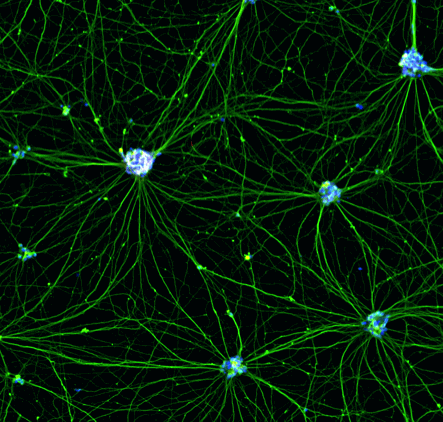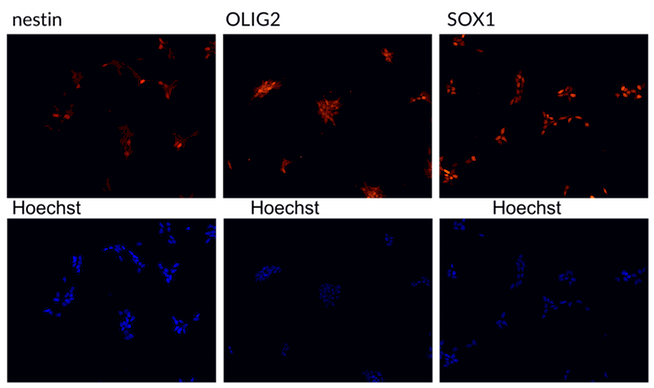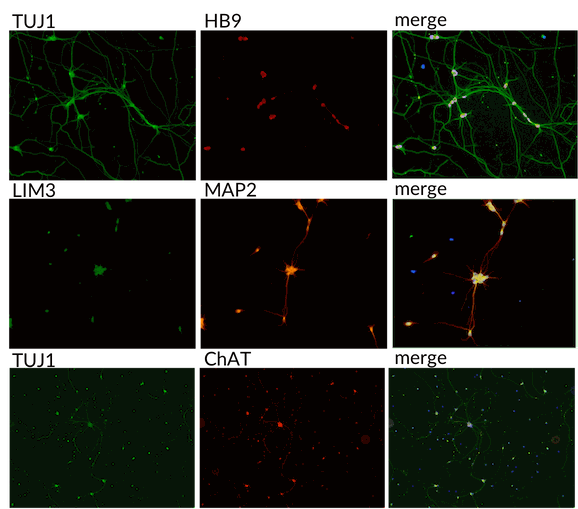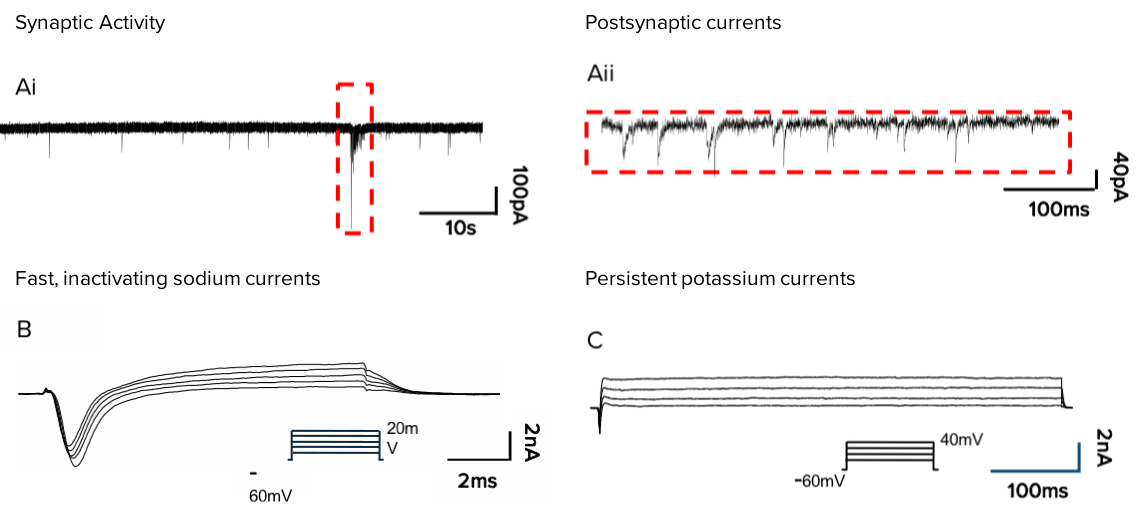Human iPSC-Derived Motor Neuron

Motor Neuron Progenitors
We have developed human iPSC-derived motor neuron progenitors from both healthy and patient donors, which can be cultured in vitro to provide a physiologically relevant alternative to conventional animal-derived models for use in proof-of principle drug-screening assays and for modelling motor neuron degeneration.
Axol’s human iPSC-derived motor neuron progenitors have been differentiated using a combination of small molecules to generate a near pure population of terminally differentiated mature functional motor neurons.
We specifically developed Motor Neuron Recovery Medium which supports cell recovery after thawing and initial progenitor cell expansion, as well as Motor Neuron Maintenance Medium which promotes the optimal differentiation and maturation of the progenitors to functional motor neurons.
Human iPSC-derived motor neuron progenitors
| Cat. No. | Product Name | Starting Material | Quantity |
|---|---|---|---|
| ax0078 | Motor Neuron Progenitors (Healthy) | Fibroblasts (74 yr Male) | ≥2 x 106 cells |
| ax0073 | Motor Neuron Progenitors (Healthy - sibling (C9ORF72 extension)) | Fibroblasts (62 yr Male) | ≥2 x 106 cells |
| ax0074 | Motor Neuron Progenitors (ALS (C9ORF72 extension)) | Fibroblasts (64 yr Female) | ≥2 x 106 cells |
| ax0178 | Human iPSC-Derived Motor Neuron Progenitor Kit (Male) | Fibroblasts (74 yr Male) | 1 Kit (≥2 x 106 cells, medium, coating reagents & growth factors) |
Motor neuron culture media and reagents
| Cat. No. | Product Name | Product Description | Quantity |
|---|---|---|---|
| ax0071 | Motor Neuron Recovery Medium | Promotes viability of motor neuron progenitors | 50 mL |
| ax0072 | Motor Neuron Maintenance Medium | For the maintenance of motor neurons | 200 mL |
| ax0041 | SureBond | Coating solution providing an optimal surface for feeder-free growth & adherence | 3 vials of SureBond (120 μL/vial) |
| ax0052 | SureBond+ReadySet | Coating reagent kit required for endpoint assays | 3 vials of SureBond (120 μL/vial) and 2 vials of ReadySet (10 mL/vial) |
| ax0044 | Unlock | Fully defined & gentle detachment buffer | 25 mL |
Phase contrast
Phase contrast images show the morphology of human iPSC-derived motor neuron progenitors upon recovery from thawing.

Phase contrast images of Axol Human iPSC-derived motor neuron progenitors at days 1, 3 and 5 after thawing. Human iPSC-derived motor neuron progenitors are seeded using motor neuron recovery medium into T-25 flasks (coated with SureBond) at a density of 100,000 cells/cm2. During initial recovery phase the motor neuron progenitors will grow as aggregated clumps as they proliferate and expand at least 3 fold. Images provided by Lucia Marani and Prof. Mark Lewis (Loughborough University).
Immunocytochemistry
Axol’s Human iPSC-Derived Motor Neuron Progenitors express cell fate markers.

Protein expression of OLIG2, nestin and SOX1 was confirmed in Axol iPSC-Derived Motor Neuron Progenitors using immunocytochemistry. iPSC-Motor Neuron Progenitors were cultured in motor neuron recovery medium (ax0071) for 3 days after thawing before staining for OLIG2, nestin and SOX1. nestin and SOX1 staining (red) confirmed early neural ectoderm marker and OLIG2 staining (red) confirmed motor neuron progenitor differentiation. Images were counterstained with Hoechst.
Axol’s human iPSC-derived motor neurons show the expression of HB9, LIM3 and ChAT, which are typically expressed in mature motor neurons.

Protein expression of HB9, LIM3 and ChAT was confirmed in Axol iPSC-derived motor neuron using immunocytochemistry. Human iPSC-motor neurons were cultured in motor neuron maintenance medium (ax0072) for 14 days post passaging before staining for motor neuron markers LIM3 (green), HB9 (red) and ChAT (red) along with staining for neural markers TUJ1 (green) and MAP2 (red). Merged images were counterstained with Hoechst.

Human iPSC-derived Motor Neurons cultured on glass coverslips coated with SureBond+ReadySet (ax0052) for 3 weeks show expression of the mature motor neuron marker SMI-32 (yellow) (neurofilament H non phosphorylated), nuclei were stained with DAPI (blue). Data kindly provided by Amit K. Chouhan, Abby Scurfield, and Dr Gareth Miles (University of St Andrews).
Electrical activity - whole cell patch clamp
Whole cell patch clamp recordings from human iPSC-derived motor neurons reveal the electrical properties and functional connectivity of our motor neurons.

Motor neurons cultured for A-B) 3 and C) 7 weeks show typical morphology when imaged using infrared – differential interference contrast (IR-DIC) microscopy. Motor neurons at 3 weeks in culture display neuronal processes and networking A) along with motor neuron cell bodies (soma) B). C) IR-DIC image shows electrode used for voltage and current clamp recordings. Data kindly provided by Amit K. Chouhan and Dr Gareth Miles (University of St Andrews).
Voltage Clamp
Axol’s Human iPSC-derived Motor Neurons show synaptic activity at 7 weeks in culture.

(Ai) Synaptic activity recorded from a Human iPSC-derived Motor Neuron using whole-cell patch-clamp technique (voltage clamp mode). (Aii) Synaptic activity shown on a faster time scale to reveal the kinetics of individual postsynaptic currents. (B) Traces showing fast, inactivating Na+ currents recorded in response to brief depolarizing voltage steps. (C) Traces showing persistent K+ currents recorded in response to longer duration depolarizing voltage steps. Data kindly provided by Amit K. Chouhan and Dr Gareth Miles (University of St Andrews).
Current Clamp
Axol’s Human iPSC-derived Motor Neurons exhibits both single and repetitive firing of action potentials upon stimulation.

Human iPSC-derived Motor Neurons were cultured for 7 weeks on SureBond+ReadySet (ax0052) coated glass coverslips (A) Trace shows a single action potential recorded from a functional iPSC-derived Motor Neuron in response to brief current injection in current clamp mode. (B) Trace shows repetitive firing of action potentials recorded from a functional iPSC-derived Motor Neuron upon step current pulse injection. (C) A train of action potentials (10Hz) elicited in an iPSC-derived Motor Neuron by a series of depolarizing current pulses. Data kindly provided by Amit K. Chouhan and Dr Gareth Miles (University of St Andrews).
Resources
Protocol
- User Guide: Human iPSC-Derived Motor Neuron Progenitors
- - How to maintain and differentiate Axol motor neuron progenitors to mature function neurons.